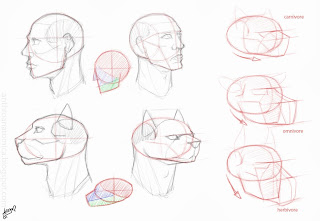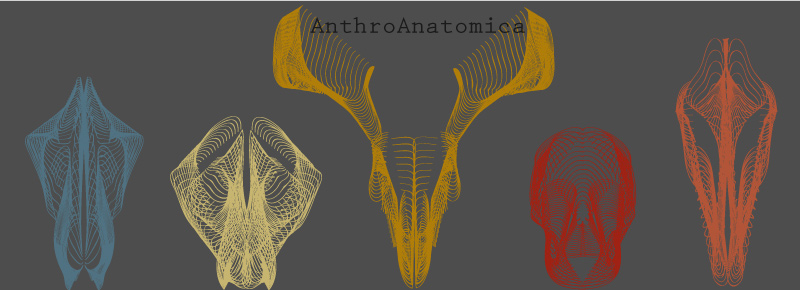Ignore the black dots in the middle, they were placeholders for the start and finish of the cycle
Tuesday 29 October 2013
Anthro run cycle
... and now the wire frame for a possible run cycle. Here I've tried to oscillate both hips to reflect their full range of motion during this cycle. The timing isn't finely tuned yet, different moments of the cycle will create faster and slower points in each limbs movement which I haven't really maximised yet. Useful as a reminder that anthro movement is very energetic, likely the arms will have to be swung in arcs to maintain balance.
Labels:
anatomy,
animation,
anthro,
anthropomorphic,
biped,
digitigrade,
elastic strain energy,
energy efficient,
how to draw,
human,
locomotion,
mechanical advantage,
unguligrade,
walk cycle,
walking
Tuesday 22 October 2013
Anthro walk cycle
A quick test of a wire frame I made of an anthro walk cycle. I think it's rather species neutral but I had a larger herbivore type in mind; not only is there rise and fall in the hips but due to the mass and stability issues of the legs, each step the leg is going to be thrown forward, creating a far amount of 'hip swagger'. This isn't efficient, as I've mentioned in previous posts, but a digitigrade or unguligrade on 2 legs isn't ever going to be.
Monday 14 October 2013
Head shapes 2
The point of looking over skulls in the first place is to gain some idea of the forms that they lend to the shape of the head and face. One aspect of creature design a friend pointed out was using these observations to help make choices in accessory design. Again, somewhat dependent on the class of species and actually if you work the problem through you end up with some plausible if not odd looking results..
 |
| Any eye wear is going to need a much wider bridge. Glasses don't have to be designed to hook round the ears but if they did the arms would need to sit higher and not to the sides like for a human. |
Sunday 6 October 2013
Head shapes
I better post some of the sketches I've been sitting on! I've been thinking about skull shapes for anthros for sometime. Previously I looked at the need for anthro skulls to have a cranial dimension like that of a human, if you're thinking intelligence it seems fitting to exaggerate an animals skull to hold a similar brain size to a humans.
Animal skulls are much more elongated front to back than a human's. Where you'd draw an average human skull as a sphere with a box below for the jaw, for an anthro you're looking more at a ovoid with a box at the front. This is so you can retain the distinct facial features such as those elongated noses and jaws. You can break this idea down further into class (I take class to mean either carnivore, omnivore or herbivore). The main distinction between them being the required jaw size to tackle their specialised foods. As a general idea, jaws tend to get both longer and deeper with herbivores; more muscular action is needed to grind plant matter, so a large bone surface is required, their food is generally in a hard to reach place, hence the long face. For either class, starting with a skull similar to that of a human guarantees you'll retain an adequate brain size.
Taking this a little further the idea of snout length is certainly up to not only the species and the class but also to your own preference. Felines tend to have a much rounder short snout, canines have a more rectangular and thin snout. Length adaptation is up to you. For example, the sketches above are for carnivores, their main principle is that their jaws are thin and sleek with large forward pointing eyes however the length of the snout is undefined.
Jaws are nothing without teeth, and teeth are distinctly specialised for each class. There are a number of other more subtle differences than teeth to think about, especially if you want to be creating expressive characters. Jaw depth i've mentioned, however it's carnivores that tend to have a much larger jaw opening range to catch and eat pray. Useful for expressions showing rage and anger. Due to their large teeth, particularly their canines, carnivores have limited side to side motion which herbivore use to rotate their jaws to grind plant matter. Side to side motions are more or less reserved to show puzzlement or thinking.
 |
| The 2 small intermediate diagrams show the distinction of cranial size (red), nose/face area (blue) and jaw (green). |
Taking this a little further the idea of snout length is certainly up to not only the species and the class but also to your own preference. Felines tend to have a much rounder short snout, canines have a more rectangular and thin snout. Length adaptation is up to you. For example, the sketches above are for carnivores, their main principle is that their jaws are thin and sleek with large forward pointing eyes however the length of the snout is undefined.
Jaws are nothing without teeth, and teeth are distinctly specialised for each class. There are a number of other more subtle differences than teeth to think about, especially if you want to be creating expressive characters. Jaw depth i've mentioned, however it's carnivores that tend to have a much larger jaw opening range to catch and eat pray. Useful for expressions showing rage and anger. Due to their large teeth, particularly their canines, carnivores have limited side to side motion which herbivore use to rotate their jaws to grind plant matter. Side to side motions are more or less reserved to show puzzlement or thinking.
 |
| Ahhhhhh a splinter! |
 |
| Huh? |
Labels:
anatomy,
anthro,
anthropomorphic,
canine,
carnivore,
comparative,
equine,
expressions,
face,
facial,
herbivore,
how to draw,
jaw,
skull,
teeth
Subscribe to:
Posts (Atom)




